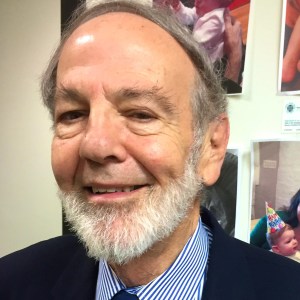“The man looked like a real Jew!”
That is what first came to mind yesterday, when I learned of the death of Rabbi Richard Levy — former director of the rabbinical school at the Los Angeles campus of Hebrew Union College-Jewish Institute of Religion; rabbi of the campus synagogue; director of spiritual growth on the campus, past-president of the Central Conference of American Rabbis; a renowned Hillel director; author and liturgist.
I admired Richard greatly.
Mostly, for this memory.
About twenty years ago, I was talking with a friend who was a leader in the Reform movement. He has since died.
Donald was then about eighty years old, born and raised in Texas, a devotee of classical Reform Judaism.
The subject of his comment was the photograph of Richard that had adorned the cover of Reform Judaism, which had once been the Reform movement’s magazine. It was of a bearded Richard Levy, wearing a kippah, wrapped in a tallit, thoughtfully and prayerfully raising his tzitzit to his lips.
“The man looked like a real Jew!” said Donald.
On the one hand, it depends on where you want to put the emphasis in the sentence.
Donald could have been saying: “The man looked like a real Jew.”
Translation: He was wearing a kippah and a tallit and he had a beard.
That has been the modern (and quite gender specific) Jewish visual image of what the real Jew should look like — Chagall, Roman Vishniac, Fiddler on the Roof.
And yes, Chabad.
Or: When Donald saw Rabbi Levy in kippah, tallit, and a beard, he was seeing the stereotypical Jew of history. He was seeing the Jew as the eternal Other.
Don saw Rabbi Levy dressed in traditional Jewish garb. A piece of the past that had snuck up upon him and had grabbed him.
This year happens to be the sixtieth anniversary of Philip Roth’s famous collection of stories, Goodbye Columbus.
There is a famous short story in that collection called “Eli the Fanatic,” one of the defining stories of modern Judaism.
It is the story of a group of assimilated Jews in a leafy Westchester suburb, who hire a Jewish lawyer named Eli Peck to drive a yeshiva of Holocaust survivors out of their community.
The town’s Jews did not like how one of the Orthodox survivors dressed when he did business in town.
Eli prevails upon the man to dress differently. He gives him one of his Brooks Brothers suits to wear.
The survivor responds by giving Eli one of his black suits.
At the end of the story, Eli dons the black garb and fumbles with the key to his back door.
“Eli,” one of his friends calls him, “Eli, there’s a Jew at your door.”
“That’s me,” said Eli. “That’s me.”
Richard Levy knew, and taught, that there are at least two ways that the inner Jew knocks on your door.
There are at least two kinds of piety in Judaism.
First, there is the inward piety of kavannah and prayer.
Richard’s appearance on that cover of Reform Judaism magazine “made” him a “real” Jew because he demonstrated something very powerful.
Judaism is an embodied tradition.
- Covering the Jewish head is a kind of piety.
- Covering the Jewish shoulders is a kind of piety.
- Lips kissing the ritual fringes is a kind of piety.
All this is Judaism.
Richard could do this, not only because he had come from the world of clal Yisrael, the larger Jewish world that respected and demanded pluralism and diversity, but because it was authentic to who he was.
Second, there is an outward piety. It also involves the body.
Richard Levy was one of that famous group of sixteen rabbis (and one lay leader, the late, lamented Al Vorspan), who were arrested in a 1964 civil rights protest in St. Augustine, Florida, the largest mass-arrest of rabbis in history.
Ironic: this week is the 55th anniversary of that moment in American Jewish history.
Read their statement.
Finally, Richard’s kaddish would have to include this reading.
It is from the “old” Reform movement siddur, Gates of Prayer — a reading that many Reform Jews never knew was in the book:
Once we learned one truth, and it was cherished or discarded, but it was one.
Now we are told that the world can be perceived by many truths; now in the reality all of us encounter, some find lessons that others deny.
One we learned one kind of life, and one reality; it too we either adopted or scorned.
But right was always right, and wrong was always wrong.
Now we are told that there are many right, that what is wrong may well be wrong for you, but right for me.
Yet we sense that some acts must be wrong for everyone, and that beyond the many half-truths is a single truth all of us may one day grasp.
That clear way, that single truth, is what we seek in coming here, to join our people who saw the eternal One when others saw only the temporal Now.






